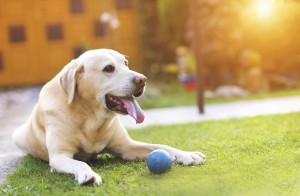Helping Your Senior Pet Through the Summer Heat
 Almost every pet – and older pets in particular – loves to find a sunny spot for a nap and well-deserved stretch. After spring rains, the urge for a senior pet to get outside for the welcomed warmth and low key exercise is understood, too. However, senior pets are often more at risk for heatstroke and heat-related stress.
Almost every pet – and older pets in particular – loves to find a sunny spot for a nap and well-deserved stretch. After spring rains, the urge for a senior pet to get outside for the welcomed warmth and low key exercise is understood, too. However, senior pets are often more at risk for heatstroke and heat-related stress.
Just as you might take a slower or modified approach to your daily exercise choices as you age, helping your older fur friend cope with the stress of the sizzling summer days requires forethought and a bit of adjustment.
Summer Awareness for the Senior Pet
The key to most activities and daily care for older or geriatric pets is moderation. Seniors may need to slow down during the warmer months, and tailoring these daily choices for our older friends will be necessary to keeping them safe.
Of course, that doesn’t mean camping on the couch all summer long. You can enjoy some outdoor recreation with your pal with a precautionary approach to his or her needs.
Keeping your cool – Senior pets often struggle with thyroid and kidney conditions which will increase their need for water intake. To help your pet stay hydrated, ensure there is a good supply of cool, fresh water throughout the home and yard. Bring your older pet in inside and maintain a cool climate to help him or her cope with the soaring temps through June, July, and August.
Making a splash – For some seniors, swimming can be a tremendously beneficial method of staying cool and getting some low impact exercise. However, older pets are often easily fatigued. For the safest approach to senior splash time, opt for a shallow lap pool with dog-friendly access steps or a kiddie pool. And, remember: all pets, no matter what their ages, need to be supervised during swim time.
Abbreviated playtime – While exercise is important for senior pets, keep the timeframe to a minimum. Rather than a 30 minute walk, consider short 10-15 minute walks at a steady, slow pace or a simple indoor game to expend some energy.
Location, location, location – If you are unsure of a destination’s availability of shade or a/c, leave your senior pet at home or at a daycare facility for the day. Beaches and other exposed areas leave our pets vulnerable to the increased heat, UV exposure, and scalding terrain. Opt for shaded parks or fun time at a pet best friend’s backyard Shangri-La instead.
Health and safety awareness – Consistent health check-ups are essential to keeping your older pet at his or her prime. If you notice a decrease in energy or disinterest in exercise, consider bringing your friend in for a wellness exam. During the visit, you can gain a lot of insight into optimal nutrition, fun and safe summer fitness ideas, as well as ways to help him or her cope with age-related mobility challenges.
Your senior pet will benefit from year-round opportunities for exercise and socialization. With a bit of adjustment to help take the burn and sizzle off of those summer excursions, your pet can continue to enjoy the outdoors with you and the family.


